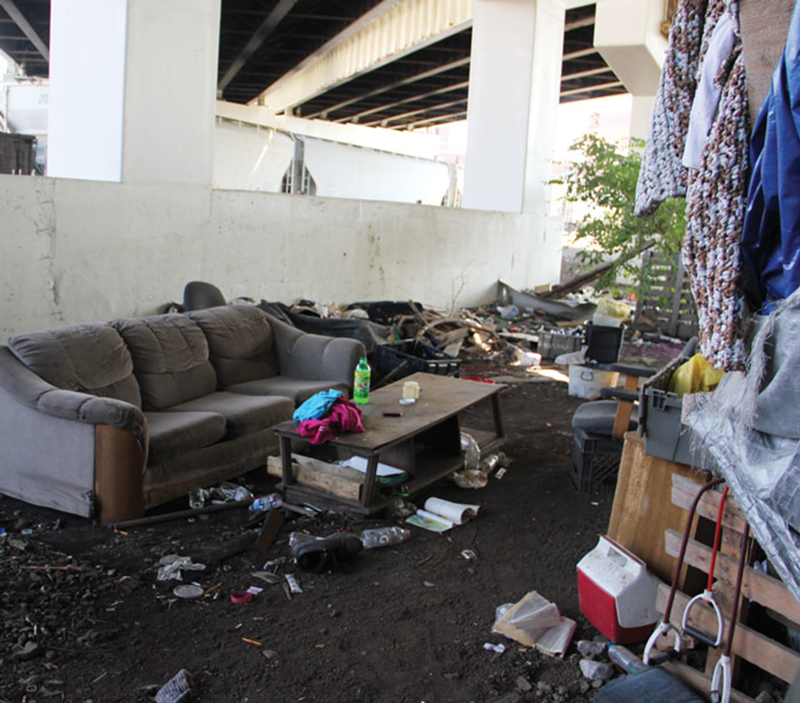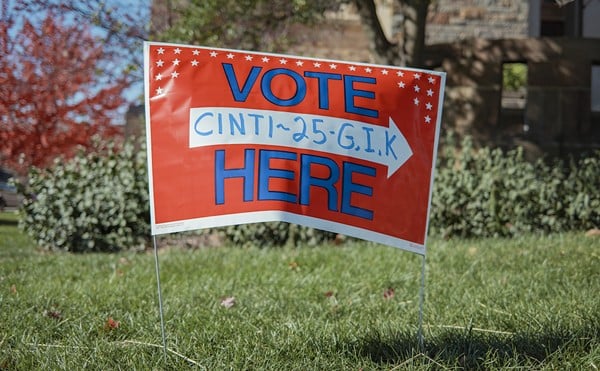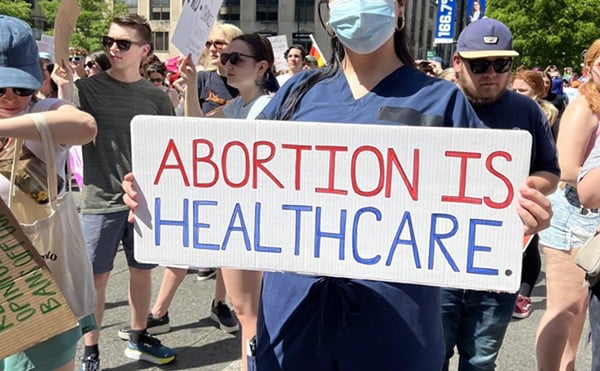It was nine days into the new year, during the doldrums of a particularly brutal Cincinnati winter, when the reports came in about the woman left lying in the road on the 600 block of West McMicken Avenue.
At first, police thought she was a hit and run victim.
They showed up about 2:30 a.m. to investigate. As flecks of snow floated down and temperatures dipped into the 20s, responders slowly animated this typically dark, quiet corridor just down the hill from Clifton Heights and Fairview. Multiple police cruisers, their lights splashing cool purple hues across the faded brick homes lining the street, blocked McMicken at its intersection with Ravine Street.
Police quickly found the gunshot wound to Jessica Revelee’s head.
Witnesses said three men hiding behind the deep tinted windows of an older maroon Chevrolet Impala were involved in the shooting, but the car was long gone by the time the police arrived.
Revelee was 24 years old with a criminal history of more than 50 incidents over the previous six years, starting with small, less-serious charges for possession of drug paraphernalia and escalating over time to arrests for theft, heroin and solicitation. Many of them occurred on West McMicken.
A month before her death, Revelee turned herself in on drug warrants and spent two days in jail. She told her father, a man named Paul Stiver, that she feared for her life because she owed money to some dangerous people involved in drugs. She said she hoped she would get more time in the safety of a jail cell, maybe a year or more, to let things cool down.
Instead, she was released quickly and turned back to the streets.
Revelee’s story captured the city’s attention. It might have been because her death was particularly brutal, or because it was already the fifth homicide in Cincinnati just nine days into 2014. Whatever the reason, a flurry of news reports recapped what happened to her and a new urgency emerged around the issue of sex work in the isolated West McMicken corridor and around the city as a whole.
“Nobody deserves this — I don’t care what she did. I don’t care if she robbed somebody,” a friend of Revelee’s named Maria Bard said during a memorial walk in the area a few days after the shooting. “Nobody deserves to be shot in the head on a freezing night and die on McMicken.”
Some of the headlines and opening paragraphs from news stories published around that time sting.
“Memorial for Murdered Young Prostitute,” one reads.
Few noted other aspects of her life. She had been a very promising student at Colerain High School just six years earlier. She had a kind heart, her friends said, sometimes letting homeless acquaintances stay in her apartment, wherever that was at the time.
She bounced around a lot, from various addresses on Mohawk Street in Over-the-Rhine to Dayton Street in the West End. That was an echo of her childhood. Revelee’s father lost custody of her in 1997, when she was 8, and after that she lived in at least a dozen foster homes.
Revelee had told many people — her father, outreach teams from social service agencies and others — that she wanted help. Help getting out of the world of sex for money. Help with her heroin addiction.
Understanding why people sell sex and why help sometimes doesn’t come in time for individuals like Revelee involves coming to terms with a dizzying array of mitigating economic, social and personal factors. Often, the worlds of coerced sex work, the city’s looming poverty problem and a heightening addiction crisis are inextricably linked.
Local leaders are working to provide resources and outreach from a number of different angles, but myriad factors present barriers to recovery for those wishing to stop selling sex.
A problem of unknown magnitude
In trying to unravel the forces at play in sex work — personal choice, trafficking, addiction, poverty, mental and emotional damage caused by abuse — it becomes clear there’s no one path into seling sex. And for those who want to leave, finding the way out can be dependent on a fragile chain of events that requires good timing, courage and the help of many other people to navigate.
Reliable statistics about the issue are difficult to find. One often-quoted statistic states that the average age of entry into commercial sex is 13. The figure originated in a 2001 study with a tiny sample size and is highly disputed among experts.
Like sex work in general, even the academics and law enforcement officials who study the issue of sex trafficking, or forced sex work, say it’s difficult to know exactly how many people are involved in it each year, nationally or in Ohio.
“Unfortunately, most of the data we have is not what we want it to be,” says Erin Meyer, anti-trafficking coordinator for the Salvation Army of Greater Cincinnati. “That’s a national and a global issue.”
Data is scarce even on the city or neighborhood level.
“Locally, it’s impossible,” says Cincinnati City Councilwoman Yvette Simpson on efforts to know exactly how many people are caught up in the sex trade in the city. She says arrests for solicitation are a “miniscule amount” of the number of instances that actually occur.
There is a lot of debate on how the issue should even be framed. Those who live in neighborhoods where sex work happens sometimes see sex workers as criminals. But social service workers are more likely to view workers as victims, not perpetrators, of crime. Law enforcement officials are starting to come around to this point of view as well.
Those who believe sex for money between consenting adults should be legalized say not all sex workers are being coerced, are addicted to drugs or face poverty. They point to places where sex work is legal like Las Vegas and some parts of Australia, for instance, and studies that show less coerced sex happens there. They also point out that not all sex work happens on the streets and claim that the Internet has made it safer and more liberating for those who wish to ply the trade.
But on the street, the line between someone willfully selling sex and someone who is forced into it in one way or another is very blurry. It’s clear many, including Revelee before she died, are subject to forces beyond their control — either at the hands of others making a profit from them or systemic and personal struggles keeping them in a dangerous lifestyle they would desperately like to escape. For those coerced into selling sex, the forces used can be insidious and subtle.
“It’s really about creating this culture of fear, in which these traffickers use a variety of tactics to really make trafficking victims feel like they can’t leave,” Meyer says. She says studies show 85 percent of sex workers have experienced some kind of abuse.
Midge Hines has been working for nine years at Caracole, an organization offering counseling and other services for people with HIV and AIDS. She says many sex workers the organization sees have trauma in their pasts, histories with poverty and displacement and uncertainty in their lives.
“For many of our clients, it’s really a search for love and acceptance,” she says of the paths that have led them to selling sex. “For some of our clients, it’s about money and power, but for many it’s something more human.”
Through Caracole, CityBeat interviewed Tara, who asked that her name be changed for publication. Tara grew up in Finneytown and has been in Cincinnati her whole life. She spends a lot of her time these days at the downtown library and at Chatfield College in Over-the-Rhine, where she’s studying to eventually become a social worker. She’s also passionate about writing.
Tara is in her forties and sold sex for four years in the neighborhood around West McMicken. She says she wasn’t forced into sex work, exactly, but neither was it something she really wanted to do. A complex mix of poverty, upbringing, self-esteem issues, addiction and outside influences — including men in her life who stood to gain from her selling sex — led to her situation.
“It had a lot to do with how I grew up,” she says.
She was quiet as a youngster, she says, a bookworm who liked to read anything she could get her hands on, but especially Danielle Steel romance novels. Her shyness, and her race — she was one of only a few black children in her school — drew ridicule from the other kids. Sexual abuse and later addiction to drugs she was using to cope further added to Tara’s challenges.
“I was molested when I was younger, and I spent my teenage years being very promiscuous, and that led me right into prostitution,” she says. “Once, some boys were outside, and they propositioned me, and I said, ‘OK, sure,’ and I took all four of them down into the basement. I’ll never forget that I did that.”
She pauses for a second, as if to decide whether to tell a secret.
“It made me feel like I was attractive,” she says of her time selling sex. “I have self-esteem issues, and so when somebody pulled over for me to get in that car, it made me feel pretty, like I was pretty enough to stop somebody. “
Tara says she didn’t have a pimp, but explains the subtler ways men in her life steered her toward sex work, including dealers and the man who first convinced her to sell sex — a boyfriend. From there, a number of male figures played roles in her addiction and her decisions to sell sex.
She says many of the people she knows who sell sex do have pimps, or dealers who also pimp them on the side in exchange for drugs. For them, as it was for Tara when she was on the streets, the threat of violence is real and constant.
“I’ve been gang-raped,” she says. “I’ve been beaten up and left for dead. I know it happens a lot. I kind of put that on myself, though. Because that was like, three or four guys and I shouldn’t have gotten in the car with three or four guys anyway.”
Tara stopped selling sex in 2007 after being arrested one too many times and discovering she had contracted HIV. She hasn’t gone back. She credits Off the Streets, a unique, long-term residential program run by Cincinnati Union Bethel for women looking to escape sex work, with helping her to stay out of the sex trade.
“The biggest thing I’ve experienced is, you never know what brought someone to that point in their life,” she says. “You don’t know what someone else’s story is. People assume that it’s about somebody smoking crack. But it’s not always about drugs. People could be doing it because that’s all they know.”
Tara’s story illustrates the difficulty in parsing the complicated line between choice and circumstance, victim and decision-maker.
It’s especially important to consider this complex knot of causes and effects as it relates to Ohio and Cincinnati, as well as efforts to help sex workers here. Interstate-75 runs just a half-mile from where Tara worked and just 1,200 feet from the spot on West McMicken where Revelee was left dead. The highway is a major corridor nationally for sex trafficking, experts say, and the dark, isolated spots in cities along the interstate are its way stations.
Isolated Corridors
West McMicken Avenue is the kind of street made possible by Cincinnati’s unique topography and history. It carves its way around the bottom of the hill on which Clifton Heights, University Heights and Fairview rest atop, representing a transition between the university neighborhoods’ grand old houses above and the industrial Mill Creek basin, full of old warehouses and factories below.
Further south, the street levels out as it flows into northern Over-the-Rhine. The corridor runs parallel to Central Parkway and I-75 for a while and is not nearly as busy as either. The area is easy to access if you know it, but isolated and hard to see otherwise. The frenetic development that marks the southern portion of OTR has not come here yet, and disinvestment in the area has left a high level of poverty and a large number of vacant structures and empty sidewalks.
Tony Walsh is the president of the West McMicken Improvement Association, a neighborhood group that works on beautification projects and advocates for the area to city government. He says the street’s layout makes it especially popular with those engaged in the sex trade.
During a town hall-style meeting about prostitution in the area this summer, Walsh explained how convenient the area is for johns.
“From one end you can get on from I-71 or come across the bridge,” Walsh said, “run down McMicken, pick up a girl, go to one of the hotels on the parkway, or some little dark spot, then head down to I-75 and you’re out of there.”
He says the situation has been deteriorating for years, becoming worse as development pushed such activities out of other parts of Over-the-Rhine.
“It wasn’t until about five years ago that all the work going on in Over-the-Rhine, on Vine Street, around the Art Academy, just put it on McMicken full-time — just entrenched,” Walsh says.
Police estimate as many as 70 sex workers did business in the corridor, many under coercion.
Walsh tells stories about pimps dragging girls by the hair, beating them and yelling at neighborhood residents, sometimes telling them point-blank not to call the police. He says last winter a woman banged on his door in the early hours of the morning, pregnant and without pants. She said she was running from a man trying to hurt her.
Then Jessica Revelee was killed.
“In January, things really started to escalate,” Simpson says. The council member was already meeting with law enforcement and the neighborhood association on the issue a year before Revelee’s death. “All of a sudden this issue became very important to a lot of people,” she says.
In April, the Cincinnati Police Department erected three barricades on West McMicken. One sat near the street’s intersection with Vine Street in Over-the-Rhine. Another was placed near the point where Revelee was shot, just before the swooping Brighton Overpass, which connects Fairview to the West End. A third sat in front of Straight Street, which runs up the hill into Clifton Heights.
The locations allowed passage in and out of the various neighborhoods the street runs through but made driving the entire length of the corridor uninterrupted impossible.
Simpson, who worked with the Cincinnati Police Department to bring about the barriers, says they were an attempt to disrupt the traffic patterns of johns cruising to buy sex. The initiative was patterned after similar efforts in Dayton, Los Angeles, Charlotte, N.C., and other cities experiencing problems with sex work and other kinds of crime.
“There’s something about illegal activity that you do in secret, and there’s a convenient place to go — you know the street to go down, you know she’s going to be there,” Simpson says. “The barricades gave us an opportunity to see what happens when you create a disruption to that.”
The barriers were controversial. Some in the neighborhood said they disrupted bus lines and made moving about on a daily basis inconvenient. Residents of nearby neighborhoods that have also struggled with prostitution, including Price Hill and Camp Washington, said sex workers and their pimps simply moved to their neighborhoods. Police dispute this, saying the barriers were effective and didn’t cause any displacement to other neighborhoods.
Other critics said the move stigmatized the neighborhood and sex workers and had the effect of making those who might be victims of the sex trade invisible. Still others pointed out the efforts focused solely on one small part of the city.
As complaints from other neighborhoods illustrate, problems with sex trafficking haven’t been confined to isolated pockets on West McMicken. Neighborhoods with a history of poverty and neglect across the city have grappled with the problem as well, including often-overlooked places like Carthage, Camp Washington and Bond Hill.
Barriers to help
Antoine Spriggs and John Keuffer had contact with Revelee just weeks before she died. Spriggs is an outreach specialist at Lighthouse Youth Services’ Sheakley Center, and Keuffer is a program director there. Lighthouse works with youth facing challenges like homelessness and substance abuse, and Sheakley is a 28-bed residential facility in Mount Auburn that runs a 30 to 35 day program for young adults.
Spriggs and Keuffer are part of a team that does outreach across the city, day and night, more than 40 hours a week. Their focus is on individuals 17-24, but they engage anyone to give help and gather information on the homeless population.
They say Revelee was looking for help getting into treatment during the months before she died. Her situation was an example of some of the roadblocks facing those seeking — and those trying to give — help.
Before sex workers actively using drugs like heroin can enter into longer-term treatment and residential programs like Off the Streets, they have to go through detox. The only game in town for medical detox, Keuffer and Spriggs say, is the Center for Chemical Addiction Treatment, often called CAT House, in the West End. It’s the one place in the city a person can get the medical care needed to detox safely, but its capacity and funding are limited.
“We were working to try and get her into treatment, into CAT House, to try to get her off the streets,” Spriggs says of Revelee. “It was just a little too late. The timing was off. That might sound weird. But when she was ready, CAT house didn’t have any beds. And then when CAT House was ready, we couldn’t find her. It’s that moment of clarity. If you have someone who is ready to go now, it’s best to get them in at that moment.”
In addition to more general outreach, the Sheakley team also undertakes sex-work specific projects the Cincinnati Police Department requests help with. Its employees observe neighborhoods where sex work has been reported, gather data to see if the reports are correct, then do outreach and advise police on the situation.
“I don’t call them prostitutes,” Keuffer said during a recent drive around the city on outreach duty. “I call them sex slave trade victims. I believe they’re all trafficked. It’s not a choice. And then the drugs … it’s all interwoven. Here at Sheakley, we’re finding that 80 percent of our clients have some form of substance abuse. Sixty percent have some form of mental health issue.”
One sunny day in August, they cruised through a few neighborhoods such as Camp Washington and Over-the-Rhine before heading to a spot in the West End that they say illustrates the dire situation some of their clients face. It’s a homeless camp tucked away behind a floodwall.
In a small clump of trees, homeless individuals have set up a few solid-looking tents, almost shacks. That’s the most established part of the camp, which has been around for years, Spriggs says. Another part, under a nearby overpass, is newer. Here, a shakier tent is set up next to a couch and a sprawl of soft drink bottles, a makeshift coffee table and food wrappers. The camp is empty. Keuffer says at least two people who live here are hooked on heroin and are also selling sex to survive.
Keuffer and Spriggs leave some water and other items, then head out for other neighborhoods.
Toward the end of their trip, after they’ve descended down McMicken into Over-the-Rhine, they run across Shane (not her real name). She’s transgender, came to Cincinnati from Charlotte, North Carolina, four years ago and has been involved in sex work here for two years. She got into sex work first, then started in on various drugs to cope.
She is friendly, even bubbly, and willing to talk with a reporter present.
“When I first moved here, I was homeless,” Shane says. “I met a friend, and they showed me the ropes. I’m trying to transition out of it, but I keep getting myself into legal trouble. I just need a little help for myself. Drug treatment, that would help. I don’t know. I just need a different route.
“I’d like to try modeling and photography some day,” she says, her voice dropping for the first time in the conversation, “but I’ve never tried to take a step to do what I want to do. Something’s always been in my way. And I do make bad choices.”
Keuffer says Shane encapsulates the challenges many homeless sex workers face, as well as a few additional ones that make things even more difficult. As a transgender individual, Shane faces an extra layer of discrimination and threats of violence.
In June, a transgender woman, Tiffany Edwards, was murdered in Walnut Hills. Another, Kendall Hampton, was killed there in August 2012. Police believe both were engaged in sex work.
“What’s stacked against Shane — she’s transgender, hooked on crack, has AIDS and is homeless,” Keuffer says. “She’s been pushed out for so long. At some point, you end up just looking for a family and love, and the love you find is kind of a sick love.”
The job of trying to help individuals like Shane has gotten a lot harder, Keuffer says, as heroin, homelessness and other factors tighten their grip on young people caught up in a lifestyle they didn’t necessarily choose.
“It’s just that cycle, man — we’re on that wheel with the rat, trying to figure out how we stop it,” Keuffer says. “It seemed much easier when we first started, and it’s gotten more complicated in the last year and a half.”
Shifts in policy — and attitudes
Policy efforts have been underway for a long time to change perceptions and legal approaches to commercial sex work, but the shift has been slow.
Outright legalization of sex work in Ohio seems like a political impossibility for the foreseeable future. But the state has taken steps to penalize sex workers less and put more focus on those who exploit them. In 2000, Congress passed the Trafficking Victims Protection Act, which sought to protect victims of sex and other forms of trafficking rather than treat them as criminals.
State Rep. Denise Driehaus, a Democrat who represents Cincinnati, says a number of bills in the state House since 2010 have advanced the issue, from creating a task force to study human trafficking to reframing the conversation and legal efforts around prostitution.
“In the past, we’ve tended to go after the victims,” she says. “When you see a woman engaged in trafficking, she used to be the one picked up and brought in. (New laws) say, wait a minute, we need to turn that around. The woman is the victim in this situation. It’s the pimp that we need to go after. It’s the person who’s creating the demand — the john — who we need to go after.”
It’s a big shift. A National Underground Railroad Freedom Center report cites a study conducted in 2009, before Ohio’s new laws, that found local law enforcement and others who deal with the issue had little knowledge about trafficking. Only 40 percent of Greater Cincinnati law enforcement officers surveyed knew about the Trafficking Victims Protection Act, for example, and most rated their knowledge of trafficking as “poor” or “fair.”
That is changing. Aside from the barricades, which came down in August, there has been a larger push in Cincinnati to help victims of sex trafficking. Simpson, social service agencies and law enforcement are looking to take more action on the issue city-wide. Some of these efforts, like barricades and shaming campaigns publishing the names and license plate numbers of johns, are controversial.
But others have more broad-based support, including increasing penalties for johns and pimps and the creation of a new kind of court, called the CHANGE docket, that is just now getting its legs. The docket, which is modeled on the county’s special mental health and veterans courts, will be presided over by Hamilton County Municipal Court Judge Heather Russell. It will allow those arrested for sex work to go through various treatment and support programs if they indicate they’re ready to make a change. The court will also help direct badly needed funds into some of those treatment programs.
That docket was first proposed by two Cincinnati Police officers who approached Russell about creating the court.
“We don’t often see that side of the police department,” says Mary Carol Melton, executive director of the Off the Streets program. She says the department also helped her create that program a decade ago. “They deserve a lot of credit because they’ve been very proactive in looking for solutions.”
These efforts, along with shifting state laws and attitudes in the community, represent the slow change happening in the way the legal system treats victims of sex work. Once one of the fastest-growing populations in Ohio’s female prison population, sex work victims female and male are more and more seen as just that — victims, either of coercive traffickers or powerful systemic and personal dynamics beyond their control.
That shift is also happening at the neighborhood level.
“We fought against prostitution for a long time,” says Walsh of the West McMicken Improvement Association. “We wanted the police to do something about it, arrest these girls, and then we slowly got educated. We never used to see the pimps. Then all of sudden there were these guys barking orders, sometimes coming across the street and beating these girls. Then we really started to become more aware about what was going on.”
Off the Streets is an example of a program created by the drive to see sex workers in a new light. In the late 1990s, Melton says, Hamilton County applied to be part of a pilot project looking at gender-specific issues for women in the justice system. Studies from that project found that women involved in sex work were among the fastest-growing populations in Ohio’s prisons.
Driven by that information, a group that included Melton, law enforcement officials and two former sex workers began planning Off the Streets a decade ago. The long-term residential program generally serves about 25 women at a time. It creates an environment where women can address the “shame and trauma” of forced sex work, Melton says, and helps them gain confidence. Melton says many women in the program had early childhood trauma, abuse and unstable family lives. But there are no absolutes.
“Having said that, we have women in the program who have said, ‘I came from a great family.’ ”
Much of the program is led by facilitators who are former sex workers themselves; women who have experienced many of the same struggles clients have faced. Melton says the program is an advanced step for women looking to leave sex work but that recovery for many is about following a long path full of hard work and the help of others.
“Detox is important, treatment is important for stability,” Melton says. “And then the Off the Streets program, if you look at it as a continuum, it really provides the environment for determining what your next steps are to reach different goals in your life.”
Ultimately, the goal of the program is to empower those who are ready to make an enormous life change, Melton says.
“We want you to hear the message that you are not what you’ve had to do to survive,” she says. “The strengths that the women have that have helped them survive on the streets are the same strengths they can use to help them make different decisions for themselves. ”
Off the Streets graduated ten women in a triumphant and emotional ceremony Oct. 31. But the battle against the forces facing sex workers is still a long road in many ways.
Just before heading back to Mount Auburn at the end of their outreach route back in August, Keuffer and Spriggs came across two young women on West McMicken. They pulled over and Keuffer struck up a conversation with them. Both were involved in sex work, they said, but had shelter in the neighborhood and were over Lighthouse’s target age.
They said they’d seen a girl in her teens, though, who had been working the streets. One of the women said the girl had family in Dayton but was a runaway.
“I’ve been seeing her almost every night,” the woman said. “It broke my heart when she told me her story.” ©









